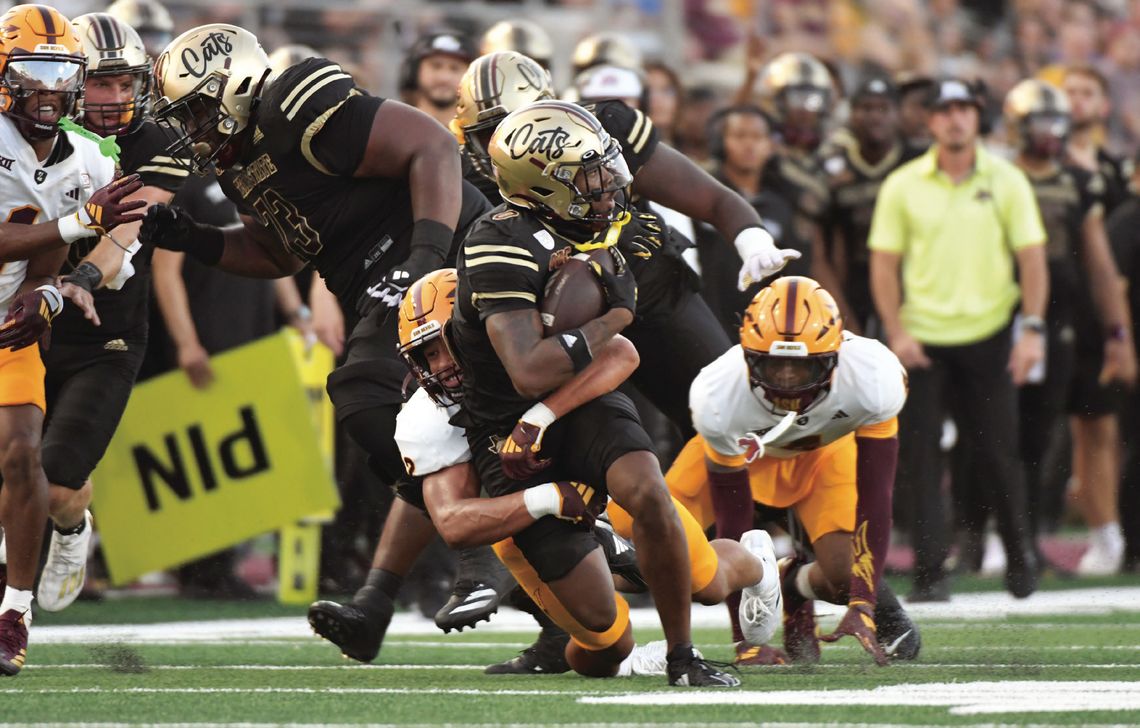TXST ATHLETICS
Where Texas State fits in as the Pac-12 adds members
With the expansion of the massively-changed Pac-12, which added Boise State, Colorado State, Fresno State and San Diego State, it begs the question as to where Texas State fits in what looks to be a new phase of realignment, especially with the conference wanting to expand its footprint in the central time zone.
Matt Brown, founder of the Extra Points Newsletter, is a leading expert in realignment and college athletics as a whole. He said that one reason the Pac-12 wants to expand into the area is to increase their television presence.
“We have seen a trend over the past few years for highly competitive conferences to throw geography to the wind and be in multiple time zones,” Brown said. “If you are in three different time zones, you have more broadcast flexibility and more windows that might be more appealing to TV partners.
“Since the Pac-12 is located in the pacific and mountain time zones where there are not as many people, having some sort of presence in the central time zone might help them drive up their value for future television contracts.”
The state of Texas and their universities are a huge target during realignment with the ACC, American Athletic, Big 12, Conference USA, SEC and Sun Belt all of which have members that reside in the state among the 13 Football Bowl Subdivision schools.
One of the reasons that Texas schools are targeted for conference realignment is the state’s affinity for college sports and recruitment of athletes.
“It’s not that big of a secret that Texas is a big recruiting territory,” Brown said. “Not just for college football but for every sport, as the population shifts into multiple Texas metropolitan areas. If any conference wants to be where college sports fans and high level recruits are, it would make sense to have some sort of presence in the state.”
Since the 1980s, Texas State has not been shy at growing the university and moving away from their regional identity. In football, the university jumped to Division I and FCS football in 1984 before making the jump to FBS in 2012.
With the university wanting to be recognized on the same level as schools such as Houston or Texas Tech, a move to the Pac-12 could be the answer, especially with the amount of revenue that is expected to be generated.
“There are two big reasons why you would be interested in this,” Brown said. “One is money. The Sun Belt is a greatly improving and growing league, but it has a relatively modest TV broadcast contract. It’s not distributing $6 million dollars a year or plus in fees. What the Pac-12 is hoping for is to set up a deal between linear and streaming that would distribute around $10 [million]. That is their hope.
“That is a significant jump in revenue and quality of competition. If the goal is to get into the most prestigious league possible, it is worth a phone call.”
The interest in adding Texas State to a more prestigious conference isn’t about what the school could do in the present but in the future.
“If you are at another [conference], you are looking at Texas State as a growth property,” Brown said. “An athletic department that has not yet reached its peak potential but is improving. There are not that many schools out there in important parts of the country that have 40,000 students and have strong future budget projections.
“You might look at this and say, ‘Yeah, they might stink a year or two but with more money, stability and structure, they can grow into something better.’ We have seen that with UCF, Tulane, and some level with UTSA. It can be done.”
But while there are reasons Texas State, or even the Pac 12, might be interested in such a move, that doesn’t necessarily make it a reality. Brown said that the Pac-12 doesn’t seem to be in the future for the Bobcats nor is the state of Texas.
“This is a fast moving and fluid situation,” Brown said. “What I have been told so far is that the institutions [in the Pac-12 that] are most interested… in the central time zone are not in Texas. The two that I have specifically heard are Tulane and Memphis. Now that doesn’t mean that the Pac-12 or the Mountain West couldn’t be interested in other institutions. I have heard consultants float UTSA, but I haven’t heard anyone in this space float Texas State.”
Another reason for the Pac-12 not wanting to add any teams in Texas is the conference wanting to stay small rather than grow into the current 14 or 16 super conferences seen today.
“The Pac-12 is looking to add members but isn’t looking to grow to 12 or 16 members,” Brown said. “They are saying eight in public but in private and [from] ‘in people’ in the industry, I have heard 10. … They are looking for members with stronger records and athletic competition.”
Texas State might not be a part of this round of realignment. Being able to move upwards from the G5 to the perceived P4 is not as easy as people may think it is.
“Class mobility in college sports is really difficult,” Brown said. “If you want to be seen as different from your Sun Belt peers, which being in the conference isn’t bad, you have to produce many years of sustained athletic and operational excellence to prove you have more in common with Texas Tech than you do with Troy.”
As long time Bobcat fans know, the fact that Texas State can be discussed in these types of situations shows just how far the university has come. The success of the Bobcat football program and the work behind the scenes from University President Kelly Damphousse, Director of Athletics Don Coryell and staff has grown the university’s image to a point that it can be in these types of conversations. Continued success will put the university in those talks.
“The fact we are able to have this conversation with a straight face is a credit to the improvement of this football program, the athletic department and the university,” Brown said. “If you continue on that trajectory and control what you can control, you are going to be fine. Before worrying about being in a slightly better league or a slightly different TV contract, what you can do is be competitive, win games and send fans to different places here and now.”
In fact, Texas State might be in a better position being the Sun Belt Conference, which has earned a strong reputation over recent years.
With the conference gaining notoriety as a premier mid-major conference in football, baseball and soccer along with the plans to improve the league’s standing as a top basketball conference, the Sun Belt has the potential to be something more.
“We are still pretty new to the Sun Belt,” Brown said. “This is a four-bid baseball league. It’s very good at soccer, and this is the first year of the 12-team college football playoffs. The national profile of the Sun Belt will elevate when they get a team in the playoff, which is definitely possible over the next couple of years. It will improve as they continue to beat Power 4 or highly regarded G5 teams out of conference.”
cmcwilliams @sanmarcosrecord.com Twitter: @ColtonBMc



